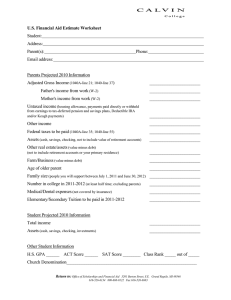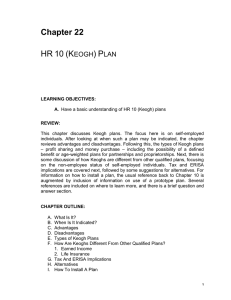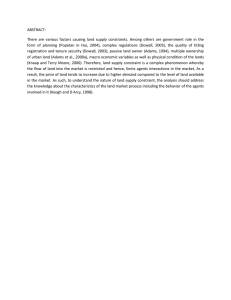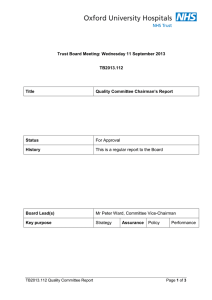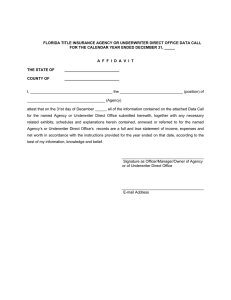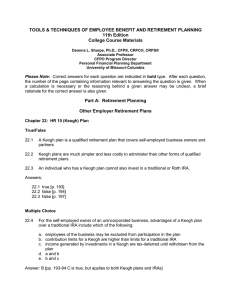HR 10 (Keogh) Plan What is it?
advertisement
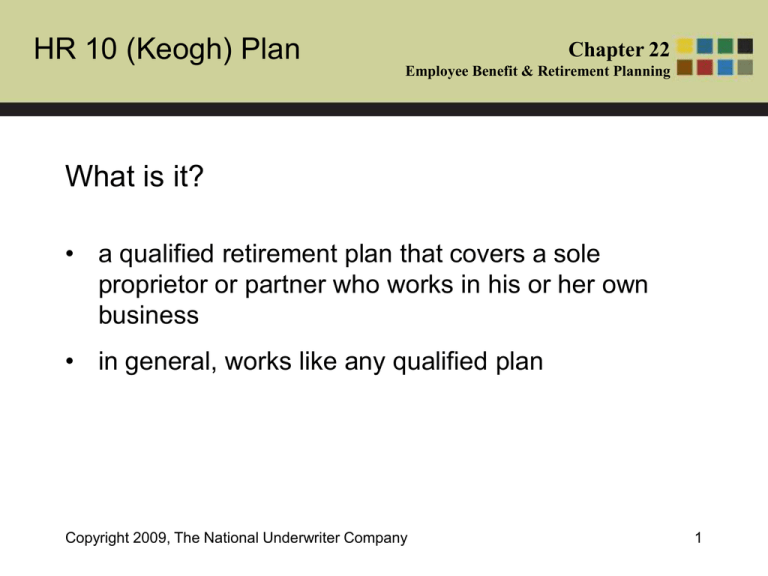
HR 10 (Keogh) Plan Chapter 22 Employee Benefit & Retirement Planning What is it? • a qualified retirement plan that covers a sole proprietor or partner who works in his or her own business • in general, works like any qualified plan Copyright 2009, The National Underwriter Company 1 HR 10 (Keogh) Plan Chapter 22 Employee Benefit & Retirement Planning When is it indicated? • self-employed business owner needs long-term capital accumulation for retirement • owner of unincorporated business wants a plan that provides retirement benefits for regular employees as well as for business owner • need to shelter self-employment income from income tax Copyright 2009, The National Underwriter Company 2 HR 10 (Keogh) Plan Chapter 22 Employee Benefit & Retirement Planning Advantages 1. Keogh contributions are deducted from gross income and tax deferred until funds withdrawn at later date 2. investment income in Keogh plan tax deferred 3. plan loans to owner-employees subject to same rules as are applied to regular employees 4. some lump-sum benefits eligible for special 10 year averaging Copyright 2009, The National Underwriter Company 3 HR 10 (Keogh) Plan Chapter 22 Employee Benefit & Retirement Planning Advantages 5. limits on Keogh plan contributions are more liberal than IRA contributions 6. business employees must participate in the plan 7. certain employers may be eligible for $500 business tax credit of up to $500 for ‘qualified startup costs’ Copyright 2009, The National Underwriter Company 4 HR 10 (Keogh) Plan Chapter 22 Employee Benefit & Retirement Planning Disadvantages 1. Keoghs involve cost and complexity of qualified plans; can minimize these factors if use prototype plans 2. large number of employees may increase costs required to meet nondiscrimination rules 3. 10% penalty plus tax on amounts withdrawn before age 59½ Copyright 2009, The National Underwriter Company 5 HR 10 (Keogh) Plan Chapter 22 Employee Benefit & Retirement Planning Disadvantages 4. Keogh plans follow qualified plan distribution rules; for more than 5% owner, distributions must begin by April 1 of year after attain age 70½, regardless of retirement status 5. life insurance for self-employed person is treated less 6. favorably than for regular employees Copyright 2009, The National Underwriter Company 6 HR 10 (Keogh) Plan Chapter 22 Employee Benefit & Retirement Planning Types of Keogh Plans typical plan is designed as profit share without a fixed contribution formula, but other forms may be used defined contribution plan – – – tax deductible contributions to limit of 25% of total payroll of plan participants flexible contributions compensation base limited to $245,000 (2009) Copyright 2009, The National Underwriter Company 7 HR 10 (Keogh) Plan Chapter 22 Employee Benefit & Retirement Planning Types of Keogh Plans 401(k) plan – can establish a solo 401(k) plan – matching contributions to 401(k) plan for self-employed person are not treated as elective employer contributions; thus not subject to $16,500 (2009) annual limits Copyright 2009, The National Underwriter Company 8 HR 10 (Keogh) Plan Chapter 22 Employee Benefit & Retirement Planning Types of Keogh Plans money purchase plan – fixed annual contribution formula of up to 25% of earned income – mandatory contributions Copyright 2009, The National Underwriter Company 9 HR 10 (Keogh) Plan Chapter 22 Employee Benefit & Retirement Planning Types of Keogh Plans defined benefit plan – advantageous for older employee – allows higher contribution level than defined contribution plans Copyright 2009, The National Underwriter Company 10 HR 10 (Keogh) Plan Chapter 22 Employee Benefit & Retirement Planning How are Keoghs Different from Other Qualified Plans? since self-employed individuals are technically not “employees,” some special rules exist regarding treatment of – earned income – life insurance Copyright 2009, The National Underwriter Company 11 HR 10 (Keogh) Plan Chapter 22 Employee Benefit & Retirement Planning How are Keoghs Different from Other Qualified Plans? earned income – for self-employed, ‘earned income’ takes the place of ‘compensation’ in applying qualified plan rules – earned income is net income from business after all deductions; deduction for 1/2 of self-employment tax must be taken before taking deduction for Keogh plan contributions Copyright 2009, The National Underwriter Company 12 HR 10 (Keogh) Plan Chapter 22 Employee Benefit & Retirement Planning How are Keoghs Different from Other Qualified Plans? life insurance – can be used as an incidental benefit in a plan covering selfemployed – the pure life insurance element of an insurance premium is NOT tax deductible Copyright 2009, The National Underwriter Company 13 HR 10 (Keogh) Plan Chapter 22 Employee Benefit & Retirement Planning How are Keoghs Different from Other Qualified Plans? life insurance (cont’d) – only the portion of the premium that exceeds the pure protection value of the insurance is deductible – Table 2001 costs, although included in income because they were nondeductible, are NOT includible in cost basis Copyright 2009, The National Underwriter Company 14 HR 10 (Keogh) Plan Chapter 22 Employee Benefit & Retirement Planning Tax and ERISA Implications • Keogh plans generally have same tax and ERISA implications as regular qualified plans • annual reporting requirement for qualified plans simplified for many Keogh and other small plans Copyright 2009, The National Underwriter Company 15 HR 10 (Keogh) Plan Chapter 22 Employee Benefit & Retirement Planning Alternatives incorporate the business and adopt a corporate plan – owner then becomes shareholder and employee of corporation – may result in higher taxes – advantage of corporate plans over Keogh plans is minimal Copyright 2009, The National Underwriter Company 16 HR 10 (Keogh) Plan Chapter 22 Employee Benefit & Retirement Planning Alternatives Simplified employee pension (SEP) or SIMPLE IRA – may be simpler to adopt than Keogh plan – SEP can be adopted as late as the individual’s tax return filing date, past the deadline to adopt a new Keogh plan Copyright 2009, The National Underwriter Company 17 HR 10 (Keogh) Plan Chapter 22 Employee Benefit & Retirement Planning Alternatives tax deductible IRA contributions – may be adopted as late as the individual’s tax return filing date, past the deadline to adopt a new Keogh plan – IRA contribution limits are much lower than Keogh plan limits Copyright 2009, The National Underwriter Company 18 HR 10 (Keogh) Plan Chapter 22 Employee Benefit & Retirement Planning How to Install a Plan Keogh plans follow installation procedure for qualified plans ‘prototype plans’ designed by bank, insurance company, mutual fund, or other financial institution are common – institution does most of the paperwork to install plan at low or no cost – self-employed must keep most or all funds invested with that institution Copyright 2009, The National Underwriter Company 19 HR 10 (Keogh) Plan Chapter 22 Employee Benefit & Retirement Planning True or False? 1. An owner of an unincorporated business can utilize a Keogh plan. 2. A person who has self-employment income as well as income from employment can use a Keogh plan to defer taxes on the self-employment income. 3. Keogh plan limits are more generous than the limits on an IRA. Copyright 2009, The National Underwriter Company 20 HR 10 (Keogh) Plan Chapter 22 Employee Benefit & Retirement Planning True or False? 4. A Keogh plan becomes more costly to administer the more employees that are covered. 5. A defined benefit plan cannot be used as a Keogh. 6. “Earned income” for the self-employed does not include a deduction for Keogh plan contributions. 7. Life insurance in a Keogh plan is treated the same way as it is in any other qualified plan. Copyright 2009, The National Underwriter Company 21 HR 10 (Keogh) Plan Chapter 22 Employee Benefit & Retirement Planning Discussion Question Suppose a self-employed person has a Keogh plan. Discuss what would happen in each of the following situations: a) plan participant becomes disabled b) plan participant dies c) plan participant wants to initiate and fund a traditional IRA or Roth IRA d) plan participant is also covered under a corporate plan as an employee Copyright 2009, The National Underwriter Company 22
